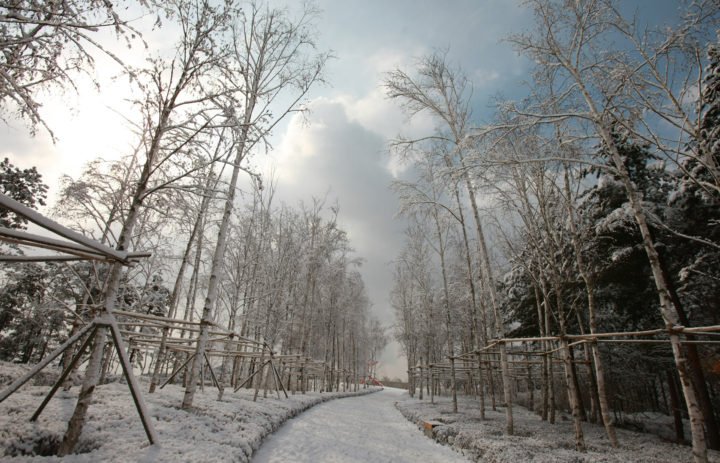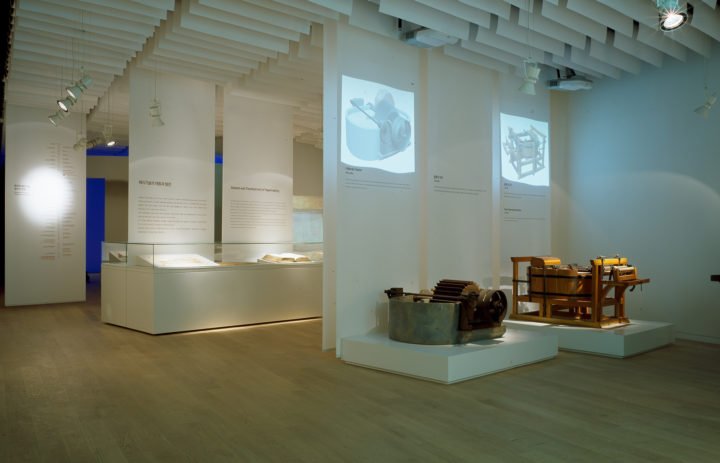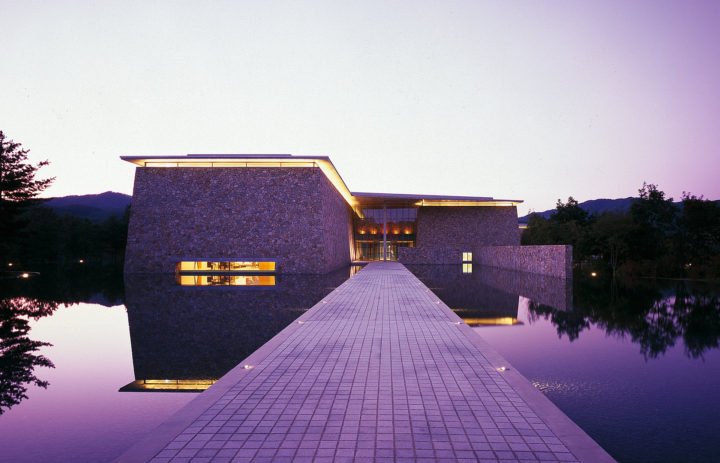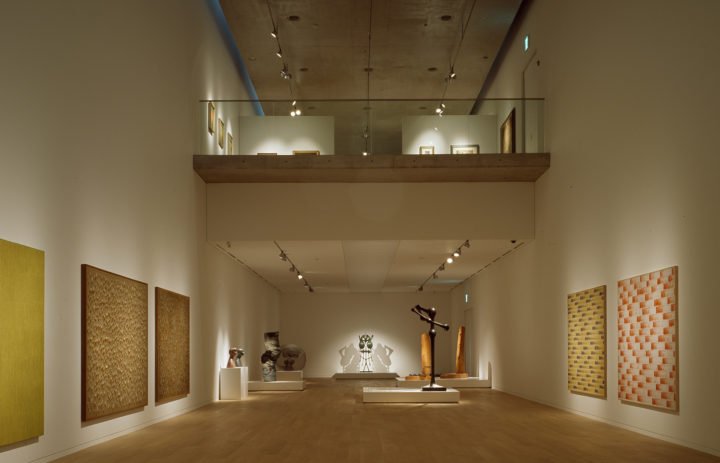Yes, it is totally worth it! Located two hours from Seoul, Museum SAN (http://www.museumsan.org) is nothing short of a pilgrimage into art. Nestled in the picturesque Gangwon-do, the Museum SAN offers both an exclusive glimpse into high-profile artists like James Turrell and a chance to re-acquaint oneself with the majesty of nature. Every detail of the museum is carefully crafted – from the architecture that pays tribute to each of the four seasons to exhibitions that explore complex themes like truth through Korean print-making. We interviewed Museum SAN to find out more about the groundbreaking approach it has taken towards melding art and nature.
Museum SAN: Most contemporary people communicate with each other on-line through various digital devices instead of direct conversations with their family and neighbors. The slogan “Disconnect to Connect” addresses this phenomenon of our individualistic culture. Disconnected from digital devices while enjoying art and nature at the Museum SAN, we hope visitors can regain their analogue sensibility sharing precious moments with their friends and family.
In planning exhibitions, we take a thematic approach focusing on a certain subject such as “rediscovery of nature” or “rediscovery of paper” rather than overemphasizing conceptual or physical aspects of contemporary art. We want to suggest an idea that is familiar to everyone yet also provoking a new perspective. We hope our exhibitions will provide viewers with interesting stories that they can share with their family and friends.
Museum SAN: Nestled in a mountain terrain, the Museum SAN’s beautiful landscape welcomes visitors with the blue sky and fragrant flowers. Its three outdoor gardens offer picturesque views throughout the year. A vast flower field is covered with 800,000 China pinks in spring and summer; autumn leaves peacefully fall on the surface of the water in the Water Garden; and snow scenes in winter create precious moments of the season. Visitors exhausted from the city life can find a peaceful rest at the Museum SAN at any time of the year. All the exhibitions are held inside the museum, while its permanent outdoor sculptures add yet another attraction.
Museum SAN: The Museum SAN was born as the Paper Gallery(a museum of paper arts) established in 1997 and the Cheongjo Gallery(an art museum) founded in 2013 were combined. Originally initiated from a private collection, it has now grown into a complex museum that aspires to share the cultural value of its collection with the public.
Museum SAN: The Museum SAN, designed by the world-renowned architect Ando Tadao, is a RE-SEUM (Resort & Museum) where architect, art and nature are harmonized offering a restful experience. There are three outdoor gardens themed with flower, water and stone respectively. Visitors can enjoy the beauty of nature visiting the main building that seems floating on the water, or walking through a pleasant path along the Stone Garden. In addition, the museum has a special exhibition hall dedicated to James Turrell, the master of light and space. It is the only space in the world that houses five representative works of Turrell. His works instilled with the aesthetics of light and infinite space are another special feature of the museum. The museum is a cultural complex composed of the Paper Galley, the first museum dedicated to paper arts in Korea, the Cheongjo Gallery housing paintings, prints and drawings from Korean contemporary art of the 20th century, and a print workshop, attracting many Korean and international visitors.
The name of the museum, Museum SAN, has several layers to it. Can you help unpack the meaning of it?
Museum SAN: The Museum SAN is situated in nature where visitors can enjoy the change of seasons. Designed by the world-renowned architect Ando Tadao, it is a space where architecture, art and nature are harmonized. Its name “SAN” stands for “Space,” “Art” and “Nature.”
Museum SAN: The Paper Gallery houses a variety of paper works from documents to paper crafts. Specializing in Korean traditional paper culture, it also emphasizes the importance of paper in the development of human civilization throughout the world. The Cheongjo Gallery, housing the collection of the Founding Chairman Mrs. Lee In-hee, was established to promote the aesthetic value of Korean modern and contemporary art.
These two galleries present the aesthetics unique to Korea focusing on paper-based arts. One of the important tasks of the museum’s exhibitions and educational programs is to create a connection between the traditional paper culture and the significance of paper in contemporary art. In addition, the print studio provides visitors with a print-making experience, a process through which paper and art meet. It also functions as a bridge that connects the Paper Gallery and the Cheongjo Gallery.
Museum SAN: Beginning with its inaugural exhibitions The Moment of Truth 1 & 2, the Cheongjo Gallery has presented exhibitions with themes related to paper or nature. The exhibitions were designed to suggest new perspectives to explore various aspects of paper and nature through exhibited works. We hope that these exhibitions can offer various experiences and ideas to viewers. Exhibitions include paintings and other experience-oriented works that can provide a pleasant and exciting experience to visitors.
Museum SAN: The unique design of the Museum SAN was inspired by Ando Tadao’s first impression on the site in 2005, which he described as a ‘peaceful rest surrounded by beautiful nature out of the hectic city life.’ Welcome Center, Flower Garden, Water Garden and Stone Garden unfold on the mountain terrain. The museum facilities extend over seven hundred meters, and the building constructed with the ‘Box in Box’ structure is peacefully harmonized with its natural surroundings. The “energy of life” mentioned by Ando Tadao is the source for a rest and freedom for mind and body away from the busy city life in the union of nature and culture.
Museum SAN: The plan to build a museum in Gangwon-do Province already begun when the Hansol Culture Foundation was established in 1995. However, there was a concern about the difficulty of attracting people all way to a museum situated in a remote mountain area of Gangwon-do. This concern was reflected in the selection of the architect as well as the collection of art works. To create a more attractive feature for visitors, we decided to bring in James Turrell’s work.
Since Turrell’s works were unique and relatively less exposed in Korea then, it was meaningful to introduce him in the context of the Museum SAN. Furthermore, the nature of his work perfectly corresponded to the environment of the museum as well as its message and direction. His work presents certain values that are much needed in Korean contemporary society.
The first contact with the artist was made in 2006. In January 2007, the Chairman and other staff of the foundation visited the Roden Crater and finally decided to commission his work. Turrell visited Korea the same year to survey the site, and suggested including more works, which the museum gladly accepted.
Conveying the aspiration of the Chairman of the foundation to build a museum in a culturally underdeveloped area and share the value of art with the public, the artist’s initial plan was eventually expanded to the current scale.
Museum SAN: It’s been three years since the inauguration of the Museum SAN, and it is now even listed in the “100 Choices of Touring Korea” of the Korea Tourism Organization. Despite the distance from the city center, the number of visitors has been increasing each year, and now seventy percent of the total visitors are from the capital area. The number of visitors has been increasing by twenty percent per year, contributing to the promotion of local tourism in Gangwon-do Province. The UK’s Financial Times praised it as “a dreamlike museum like no other,” and the Singaporean magazine The Artling chose it as one of the “four destination museums in Asia you must visit before you die.” The Museum SAN has become an attractive cultural destination both for Korean and international tourists.
Museum SAN: We want to introduce art works that have a distinctive aesthetic quality rather than those overly focusing on conceptualism or sensationalism. We want to offer art that can be easily integrated into our life enriching it with its beauty. We try to convey this message to viewers clearly.
In designing an exhibition, we utilize explanatory texts to help viewers better understand the exhibited works. In addition, we provide various experience programs accompanying each exhibition. Art works are installed in consideration of the audience’s perspective, and lighting is adjusted for the best viewing condition. Also, exhibitions are designed to facilitate the most comfortable and natural visitor circulation.
A docent tour is offered three times a day during weekdays and five times a day during weekend. Also, a special exhibition tour can be arranged for a group more than twenty people with a reservation made a week in advance. Besides the docent tour, exhibition guides are always ready to help the audience. The Museum SAN aspires to communicate with people offering a pleasant and exciting experience to all. Our exhibitions are designed to achieve this goal.
- Photos courtesy of Museum SAN




















